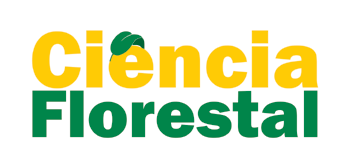Resumo em Português:
RESUMO A conversão de uma área de vegetação natural para uma área de cultivo associada às mudanças na cobertura vegetal podem acarretar modificações em algumas propriedades do solo, interferindo em sua qualidade. Dessa forma, o trabalho teve o objetivo de avaliar as alterações ocorridas nas propriedades físicas e químicas de um solo arenoso sob vegetação de campo nativo após a implantação de povoamentos de Eucalyptus dunnii Maiden, em diferentes densidades populacionais. O trabalho foi realizado na região da Campanha Gaúcha, município de São Francisco de Assis-RS. Foi instalado um experimento implantado com Eucalyptus dunnii Maiden sobre campo nativo, nos espaçamentos 3,50 m x 3,50 m; 3,50 m x 1,75 m; 1,75 m x 1,75 m e 1,75 m x 0,87 m, em um Argissolo Vermelho Distrófico. O delineamento experimental utilizado foi o de blocos ao acaso, com quatro repetições. Foram coletadas, em cada unidade experimental, amostras de solo nas profundidades de 0,00-0,10 m; 0,10-0,20 m e 0,20-0,40 m antes e após 12 meses da implantação. As propriedades físicas do solo avaliadas foram densidade, porosidade total, macroporosidade, microporosidade do solo e distribuição do tamanho dos agregados estáveis em água. As propriedades químicas determinadas foram: pH H2O, alumínio (Al), cálcio (Ca), magnésio (Mg), e potássio (K) trocáveis, fósforo disponível (P), nitrogênio total (N) e carbono orgânico total (C). Ocorreram alterações significativas na macro e microporosidade, na porcentagem dos agregados pertencentes à classe de tamanho de 8,00-4,75 mm e no DMG devido às práticas de preparo do solo e do manejo do povoamento no período inicial. Para as propriedades químicas do solo, houve aumento no pH e nos níveis de Ca no solo após 12 meses devido ao efeito da adubação aplicada.
Resumo em Inglês:
ABSTRACT The conversion of natural vegetation to cultivated areas as well as changes in vegetation cover can lead to changes in some soil properties, interfering on their quality. Such changes occur in the soil structure and in the chemical properties. Therefore, the study has the objective to evaluate the changes in the physical and chemical properties of an Ultisol after afforestation of Eucalyptus dunnii Maiden planted in different spacing resulting in several plant populations. The study was accomplished in ‘Campanha Gaúcha’ region, in São Francisco de Assis city, Rio Grande do Sul state (RS). It was carried out an experiment planted with Eucalyptus dunnii Maiden planted on Ultisol with native grass. The plant spacings used were: 3,50 m x 3,50 m; 3,50 m x 1,75 m; 1,75 m 1,75 m and 1,75 m x 0,87 m. The experimental design was a complete randomized block with four replicates. It was collected soil samples were taken before the Eucalyptus planting and after twelve months, and layers of 0,00-0,10 m; 0,10-0,20 m and 0,20-0,40 m. The soil physical properties measured were: bulk density, total, macro and microporosity and wet aggregate size distribution. The soil chemical measured were: water pH, Al+++, Ca++, Mg++, K+, available P, N and C. There were change in the macro and microporosity, in the percentage of stable aggregates of size class 8,00-4,75 mm and DMG because to soil tillage and forest management. For the chemical properties there were increase in the pH and Ca content in the soil after twelve months by effect to fertilization applied.
